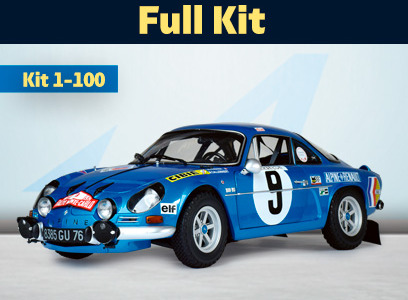-
MenuBack
-
COLLECTIONS
-
-
24h00 Le Mans
-
Alpine A110 1600S
-
Lancia 037
-
-
-
FULL KIT
-
-
FULL KIT
-
-
- ACCESSORIES
- Australian
- MAQMADON
-
Assembly guides
-
-
Blog Ixo
-
- FAQ
Alpine A470 - 2018
Alpine A470 - 2018
FROM RALLYING TO ENDURANCE
Renault's sports car brand, much like Fiat's Abarth and Mercedes' AMG. It was acquired by Renault in 1973, after a long collaboration, and today its name is used for production models that are either sports cars or intended for endurance or Formula 1 competitions.

Alpine's history began in 1952, when Jean Rédélé, the son of a Dieppe Renault agent who had become a dealer for the brand in 1946, started creating models derived from production types. The first model, built in small series on a Renault 4CV chassis and based on a design by Giovanni Michelotti, was called the A106. It was powered by an advanced version of the Renault 4CV engine and had a body made of resin and fibreglass. Its success was due to its light weight and relatively inexpensive standard engine, which was easy to upgrade with the spare parts available. The most successful model appeared in 1962 with the name A110, which still identifies a legendary car to this very day. Initially fitted with a 956cc engine mounted in the rear of a central-beam chassis, the car evolved In 1969, the most advanced version was fitted with a 1,600 cm3 engine producing 148 bhp. The first victories encouraged Renault to invest in Alpine. The A110 won numerous races, including the Monte Carlo Rally in 1971 and the World Rally Championship in 1973, beating competitors such as Porsche, Lancia and Ford. On the racetrack, Alpine made its name with the M63, which won its class at the 1,000km Nürburgring in 1963. The company continued to build single-seaters, still with Renault engines, for F2 and F3 races.

The legendary A110 rally car, twice winner of the Monte Carlo Rally: in 1971 with Andersson-Stone and in 1973 with Andruet-Petit. © IXO Collections SAS - Tous droits réservés.
It tried to enter F1 by producing a 3,000cc V8 engine with Gordini for the 1968 season, but the project failed because it was unable to compete with the Ford Cosworth. The A110 was joined in 1971 by the A310, still equipped with a powertrain that was derived from the series production, but unable to compete with new-generation sports cars such as the Lancia Stratos. Research work included an F1 single-seater from 1975-1976, with a 1,500 cm3 turbocharged engine that served as the basis for the 1977 RS01. The A310 was replaced in 1985 by the GTA, and six years later the A610 was launched, ending its career in 1995. The Alpine name was used for years by Renault to distinguish the sports variants of its production models, such as the turbocharged R5, R11 and R21.
.jpg)
Pironi-Jaussaud's Renault Alpine A442B, the first absolute winner of the 1978 Le Mans 24 Hours. The 2-litre turbo engine developed 490 bhp. © IXO Collections SAS - Tous droits réservés.
At the end of 1995, Renault dropped the name Alpine, only to resurrect it in 2012. After a series of concept cars, a new A110 was launched in 2017, incorporating the same stylistic elements as its predecessors. In endurance racing, after the experiments of the late 1960s with the 1,000, 1,300 and 1,500 cc A210 (105 to 157 bhp), and the 310 bhp 3-litre A220, a new era began with the 1973 A440, which was entered in the European Sport-Prototype Championship in the 2-litre class, a championship that Alpine won the following year with the A441. The jump to the world championship was made in 1976 with the 490bhp A442 two-litre turbo, which claimed pole position in the 24 Hours of Le Mans. Success in the French classic came in 1978 with the A442B, after which Renault devoted itself exclusively to Formula 1 racing. The Alpine name reappeared with the A450 in 2013, winning the European Le Mans Series that year and the one thereafter.

The Alpine A110, winner of the FIA R-GT two-wheel drive category at the Monte Carlo Rally on 25 January 2021. © IXO Collections SAS - Tous droits réservés.
During the 2015 season, the cars were driven by Signatech, a successful partnership that began in 2013 and is still ongoing. In 2016, the A460, powered by a 4.5-litre, 550bhp Nissan V8 engine, won the LMP2 category at Le Mans and other events to claim the world title. In 2017, with the A470, developed by Oreca and powered by a Gibson V8 engine, Alpine came third in the championship, while in 2018-2019 it twice won at Le Mans and also taking the world title. Since 2021, Alpine returned to Formula 1 and endurance racing at world level, where it finished second in the highest category, the Hypercar, with a car built on an Oreca chassis and powered by a Gibson engine.

The Alpine No. 36, the 2018-2019 world champion, pictured here on the track in Barcelona. © IXO Collections SAS - Tous droits réservés.
Share this post





 Français
Français Anglais
Anglais Allemand
Allemand Espagnol
Espagnol Italien
Italien Portugal
Portugal


